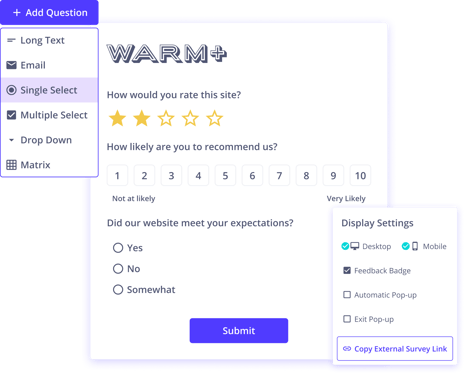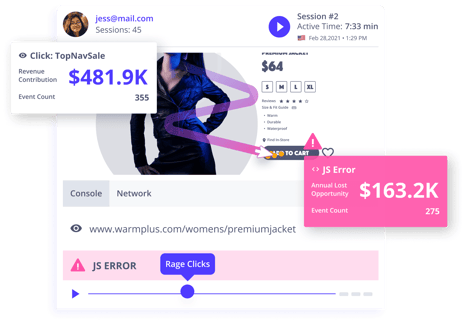Happy and satisfied customers are essential to growing your business. Research by Deloitte and Touche found that customer-centric companies were 60% more profitable than companies that were not focused on the customer. Customer satisfaction score (CSAT) is a CX metric that measures short-term happiness, or how a customer feels about a specific product or service. Unlike NPS, which is primarily a relationship study metric, and CES, a purely transactional metric, CSAT is versatile and can be used for various purposes
In this blog, we quickly take a look at calculating CSAT, share 5 tips to create great CSAT surveys and then elaborate on how you can derive more value from your CSAT scores.
Calculating customer satisfaction score (CSAT)
CSAT score assesses customer experiences by asking a single question or series of queries. You can capture customer responses using Likert or numerical scales and quantify them as a percentage. Higher the ratio, the better the customer satisfaction. Here’s how you calculate CSAT:

Calculating CSAT
The first step in measuring CSAT is creating a CSAT survey that gathers sufficient responses. Here are 5 tips to make one:
Tip #1: Set clear objectives
Since CSAT surveys can be used for assessing different aspects of your business, it is crucial to have clear objectives before starting out. For example, are you trying to evaluate the performance of customer-facing units and staff? Are you trying to gain more insights from a customer on a recently launched product? Once you have clearly defined goals in place, everything from targeting to timing the survey becomes easier.
Tip #2: Target the right audience
You need to send your surveys to the right audience to gather enough responses for an accurate CSAT score. You can send it out based on the traditional demographics like age, gender, location, and so on. Based on survey objectives, you can also target a specific set of people like customers who have purchased a particular product in the past three months.
Tip #3: Optimize survey timing
If you give customers the option to fill out a survey whenever they want, you will only get responses from customers clicking a button, skewing your results. Instead, trigger your surveys based on purchase completion, ticket resolution, and other events where you want to assess customer experience. In addition, avoid surveying the same clients too often, as that might result in high dropout rates or clients asking to be taken off your list.
Tip #4: Ask relevant questions
Go through every question in your survey and ask yourself if it aligns with the survey objectives. Don’t shy away from eliminating unnecessary questions that simply add length to your survey. At the same time, you must add open-ended questions to get qualitative data about how your customers feel. One way to find the right balance in your survey is to begin with, brief, easy-to-answer questions and then follow up with open-ended questions
Tip #5: Use simple language
Keeping your survey simple is key to getting your customers to complete it. Never assume that your customers are knowledgeable about specific topics. Your respondents don’t want to be bombarded with jargon, industry-specific terminology, or obscure acronyms for investing their time into your survey
Creating top-notch CSAT surveys and more with Auryc
In addition to creating excellent CSAT surveys, you must also have the right analytics to get a 360-degree view of your customer experience. So, is there a way to quickly implement the tips in this blog in your CSAT survey and then analyze the data with powerful tools? Yes, and the answer is Auryc.
Auryc is a customer experience intelligence platform that optimizes every customer experience across web and mobile to drive more revenue. It captures 100% of engagement events and content for customers and visitors - a high fidelity record of users’ digital journeys, including clicks, views, swipes, user input, system performance data plus CES, CSAT surveys, and feedback. Auryc provides you with a range of tools to not only efficiently measure CSAT but gain more valuable insights:
- Self-survey tool
Auryc’s self-survey tool helps you create highly configurable and brandable CSAT surveys. You can choose 3-5 topics and get started with your survey without any coding or development resources. In addition, you can ask questions in multiple formats to get both quantitative and qualitative data. Auryc also offers a library of survey questions based on surveying best practices so that you ask only relevant questions to your customers.
- VoC
Deploy your surveys at the right time and gather valuable customer feedback using Voice of the Customer (VoC). You can trigger your CSAT surveys based on customer behavior to maximize your response rate.

Gather valuable customer feedback with VoC
- Session replays
Building a great customer experience doesn’t stop with creating an awesome survey or calculating your CSAT score. You need to get deeper context into customer behavior and understand their problems. Session replays allow you to record detailed user sessions to visualize where your customers struggle so that you can improve your customer experience.

Use session recordings to improve your customer experience
Auryc is changing the way companies build better experiences for their customer. Whether you’re an analyst or a product marketer, you can use Auryc’s features to create memorable customer experiences. And that too, with no coding knowledge because Auryc is a no-code analytics platform! You can leverage the powerful suite of tools that Auryc provides by booking a demo today.


